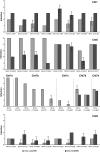Possible implications of chytrid parasitism for population subdivision in freshwater cyanobacteria of the genus Planktothrix
- PMID: 21169434
- PMCID: PMC3067206
- DOI: 10.1128/AEM.02153-10
Possible implications of chytrid parasitism for population subdivision in freshwater cyanobacteria of the genus Planktothrix
Abstract
Populations of the cyanobacterium Planktothrix comprise multiple coexisting oligopeptide chemotypes that can behave differently in nature. We tested whether this population subdivision can, in principle, be driven by parasitic chytrid fungi, which are almost neglected agents of Planktothrix mortality. Two chytrid strains, Chy-Lys2009 and Chy-Kol2008, were isolated from Planktothrix-dominated lakes in Norway. The two strains shared 98.2% and 86.2% of their 28S and internal transcribe spacer rRNA gene sequences, respectively. A phylogenetic analysis placed them in the order Rhizophydiales family Angulomycetaceae. Chy-Lys2009 and Chy-Kol2008 could completely lyse Planktothrix cultures within days, while they failed to infect other filamentous cyanobacteria. The effect on Planktothrix was chemotype dependent, and both chytrid strains showed distinct chemotype preferences. These findings identify chytrid fungi infecting Planktothrix as highly potent and specialized parasites which may exert strong selective pressure on their hosts. According to established hypotheses on host-parasite coevolution, parasitism with the above properties may result in subdivision of Planktothrix populations into coexisting chemotypes and periodic shifts in the relative Planktothrix chemotype composition. These predictions are in agreement with field observations. Moreover, a genetic analysis verified the co-occurrence of Chy-Lys2009 and Chy-Kol2008 or related chytrid strains along with distinct Planktothrix chemotypes in at least one water body. Our findings are consistent with a scenario where chytrid parasitism is one driving force of Planktothrix population subdivision, which in turn leads to polymorphism in parasitic chytrid fungi. Future studies should test the validity of this scenario under field conditions.
Figures


References
-
- Ali, M. F., et al. 2002. Antimicrobial peptides and protease inhibitors in the skin secretions of the crawfish frog, Rana areolata. Biochim. Biophys. Acta Proteins Proteomics 1601:55-63. - PubMed
-
- Baumann, H. I., and F. Jüttner. 2008. Inter-annual stability of oligopeptide patterns of Planktothrix rubescens blooms and mass mortality of Daphnia in Lake Hallwilersee. Limnologica 38:350-359.
-
- Beard, S. J., P. A. Davis, D. Iglesias-Rodríguez, O. M. Skulberg, and A. E. Walsby. 2000. Gas vesicle genes in Planktothrix spp. from Nordic lakes: strains with weak gas vesicles possess a longer variant of gvpC. Microbiology 146:2009-2018. - PubMed
-
- Bell, G. 1982. The masterpiece of nature: the evolution and genetics of sexuality. University of California Press, Berkeley, CA.
Publication types
MeSH terms
Substances
Associated data
- Actions
- Actions
LinkOut - more resources
Full Text Sources

